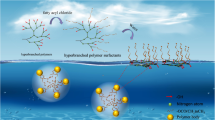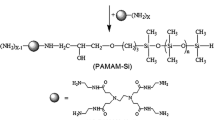Abstract
A series of hyperbranched linear surfactants (HLS) was prepared by using oleic acid modifying the first generation hydroxyl-terminated hyperbranched polymer (HBP-1), which was obtained through a step synthesis method using trimethylolpropane and N,N-dihydroxyethyl dodecylamine -3-amine-methyl propionate (AB2-type monomer). AB2—type monomer was obtained through the Michael addition reaction of methyl acrylate and diethanol amine. Single-factor experiments were conducted to investigate the influences of reaction conditions such as temperature, oleic acid dosage, and reaction time on the synthesis of HLS. Results indicate that the optimal temperature and time of the esterification reaction were 130 °C and 3 h, respectively. The structures of HLS were characterized by Fourier transform infrared spectrophotometry (FT-IR) and the results indicate that HBP-1 had been successfully modified by oleic acid. Furthermore, the surface tension and the critical micelle concentration (CMC) of the HLS solution show that HLS can significantly reduce the surface tension of water.






Similar content being viewed by others
References
Franc G, Badetti E, Collière V, Majoral JP (2009) Dendritic structures within dendritic structures: dendrimer-induced formation and self-assembly of nanoparticle networks. Nanoscale 1:233–237
Domitner J, Kharicha A, Wu M, Ludwig A (2012) Application of microprobe analysis to the reconstruction and characterization of dendritic structures. Metall Mater Trans A 44:607–616
Kim SJ, Kang HG, Choi J (2010) Surfactant-free preparation of ZnO dendritic structures by electrochemical method. Curr Appl Phys 10:740–743
Arkas M, Tsiourvas D, Paleos CM (2010) Functional dendritic polymers for the development of hybrid materials for water purification. Mater Eng 295:883–898
Percec V, Wilson DA, Leowanawat PL, Wilson CJ (2010) Self-Assembly of Janus dendrimers into uniform dendrimersomes and other complex architectures. Science 328:1009–1014
Yan DY, Gao C, Frey H (2011) Hyperbranched polymers: synthesis, properties, and applications. Angewandte Chemie International Edition, pp 36–39
Tian W, Fan XD, Kong J, Liu YY, Liu T, Huang Y (2010) Novel supramolecular system of amphiphilic hyperbranched polymer with β-cyclodextrin and hyperbranched topography cavities: synthesis and selective encapsulation. Polymer 51:2556–2564
Watkins Diana M, Sayed-Sweet Yasmin, Klimash June W, Turro Nicholas J, Tomalia Donald A (1997) Dendrimers with hydrophobic cores and the formation of supramolecular dendrimer-surfactant assemblies. Langmuir 13:3136–3141
Liu CH, Gao C, Yan DY (2006) Synergistic supramolecular encapsulation of amphiphilic hyperbranched polymer to dyes. Macromolecules 39:8102–8111
Kitajyo Y, Imai T, Sakai Y, Tamaki M (2007) Encapsulation-release property of amphiphilic hyperbranched d-glucan as a unimolecular reverse micelle. Polymer 48:1237–1242
An SG, Li GH, Cho CG (2006) Synthesis of amphiphilic star block copolymers of polystyrene with PEG core via ATRP-control of chain architecture and the formation of core–shell type globular structure. Polymer 47:4154–4162
Taniguchi Yoshinao, Ogawa Megumi, Gang Wei, Saitoh Hirohshi, Fujiki Kazuhiro, Yamauchi Takeshi, Tsubokawa Norio (2008) Preparation of hyperfunctional carbon black by grafting of hyperbranched polyester onto the surface. Mater Chem Phys 108:397–402
Marion HM, Rissmann R, Joke A, Bouwstra E, Hennink W (2006) Synthesis and characterization of hyperbranched polyglycerol hydrogels. Biomaterials 27:5471–5479
Kaneko Y, Imai Y, Shirai K, Yamauchi T, Tsubokawa N (2006) Preparation and properties of hyper branched poly (amidoamine) grafted onto a colloidal silica surface. Colloids Surf A 289:212–218
Chen DM, Chen J, Luan XL, Ji HP, Xia ZG (2011) Characterization of anion–cationic surfactants modified montmorillonite and its application for the removal of methyl orange. Chem Eng J 171:1150–1158
Kanaras AG, Sönnichsen C, Liu H, Alivisatos AP (2005) Controlled synthesis of hyperbranched inorganic nanocrystals with rich three-dimensional structures. Nano Lett 11:2164–2167
Liu HJ, Chen Y, Zhu DD, Shen Z, Stiriba SE (2007) Hyperbranched polyethylenimines as versatile precursors for the preparation of different type of unimolecular micelles. React Funct Polym 67:383–395
Cheng HX, Wang SG, Yang JT, Zhou YF, Yan DY (2009) Synthesis and self-assembly of amphiphilic hyperbranched polyglycerols modified with palmitoyl chloride. J Colloid Interface Sci 337:278–284
Tian HY, Deng C, Lin H, Sun JR, Deng MX, Chen XS, Jing XB (2005) Biodegradable cationic PEG-PEI-PBLG hyperbranched block copolymer synthesis and micelle characterization. Biomaterials 26:4209–4217
Kantchev EA, Bader SJ, Parquette JR (2005) Oligosaccharide synthesis on a soluble, hyperbranched polymer support via thioglycoside activation. Tetraehdron 61:8329–8338
Tully DC, Fréchet JMJ (2001) Dendrimers at surfaces and interfaces: chemistry and applications. Chem Commun 14:1229–1239
Fang YG, Xu C, Zhu M (2011) Catalysis of chlorolactonization of pentenoic acids with hyper valent iodine(III) reagent. Chem J Chin Univ 12:2782–2786
Acknowledgments
This study was supported by National Natural Science Foundation (21276151), National Science Foundation for Young Scientists (51103082), China Postdoctoral Science Foundation funded project (2012M521733), Light Chemical Additives in Shaanxi Key Laboratory of Scientific Research Projects (2011SZS007), Project Doctoral Fund of Ministry of Education of China (20106125110003) and the Innovation Foundation of Graduate Student in Shaanxi University of Science and Technology.
Author information
Authors and Affiliations
Corresponding author
About this article
Cite this article
Qiang, T., Bu, Q., Huang, Z. et al. Synthesis and Characterization of Hyperbranched Linear Surfactants. J Surfact Deterg 17, 215–221 (2014). https://doi.org/10.1007/s11743-013-1484-y
Received:
Accepted:
Published:
Issue Date:
DOI: https://doi.org/10.1007/s11743-013-1484-y




